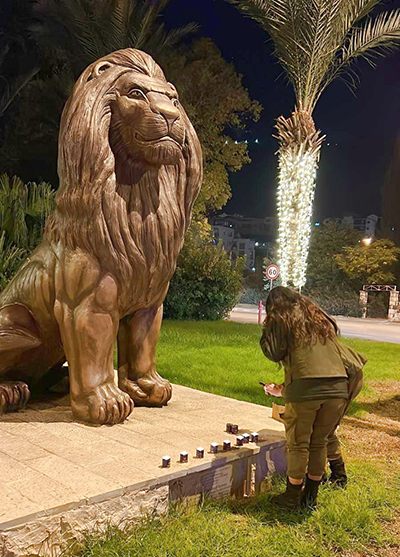By Jerry Klinger

KIRYAT SHEMONA, Israel — “Kiryat Shemona” means the Town of the Eight. It is an unusual name to those unaware of how many place names in Israel reflect the historical Jewish struggle to live in their ancient homeland.
In the upper northwest of the modern State of Israel, Kiryat Shemona is surrounded by much natural beauty as part of the beautiful Hula Valley. The longest cable car in Israel, not operational currently, rises from the city to the top of the Manara Cliffs in the Naphtali Range. The air atop is cool and pleasant. A magnificent view spreads across the verdant valley. To the northeast is the Golan Heights and snow-capped Mt. Hermon. The Syrian border is just behind. A handful of kilometers directly north is southern Lebanon. The Yellow Hezbollah flag, with the clenched fist aggressively holding a rifle up high, flutters freely, seemingly right up to the Israeli side. The flag of Lebanon is rarely seen. Hezbollah Missiles have periodically crashed, indiscriminately, on Kiryat Shemona. Since October 7, the sky has rained with Hezbollah rockets.
Kiryat Shemona struggles under the assaults. Its people are largely Moroccan and Russian refugees/immigrants. They refuse to surrender their homes or capitulate. They have known modern Jewish ethnic cleansing and vicious antisemitism from where they were from. They have no other home but Israel. They are made of stern metal.
Terror is not unknown to Kiryat Shemona. In 1974, terrorists from Lebanon, associated with the Popular Front for the Liberation of Palestine, infiltrated the city. They attacked unarmed civilians, killing eighteen. Eight of the dead were children. They had hoped for more when they took over the Janus Korczak elementary school. Their timing was poor. There were no children at the school because of the Passover holiday. Janus Korczak was a Polish pediatrician, educator, and child advocate. He was killed in the Holocaust by the Nazis after refusing to abandon the 192 orphans under his care.
A few kilometers to the North of Kiryat Shemona is the National Historical Memorial of Tel Hai. Tel Hai means the Hill of Life. It is an ironic name. Kiryat Shemona is named after the eight Jewish victims of Arab banditry and aggressive intolerance of Jews returning to live on land they had legally purchased at Tel Hai. Ostensibly, the Jews were attacked because the Arabs said they were hiding French soldiers during the Franco-Syrian war. They were not. The eight victims, men and women, were defending the tiny agricultural settlement of Tel Hai. The defenders were led by Joseph Trumpeldor, a mythic proportioned, one-armed, Russian immigrant Zionist soldier. It was an uneven fight, hundreds against a handful of poorly armed Jews.
The eight were buried in a common grave. Their sacrifice became a national symbol of Jewish courage, determination, and belief in Jewish rights. Though driven from the Land many times, Jews have continually returned.
Part of Kiryat Shemona is built on land once occupied by the attackers of Tel Hai.
Deniers of Jewish historical presence and legitimacy in Northern Israel were recently dealt a serious blow by archeologists.
Twelve kilometers northeast of Kiryat Shemona is Tel Dan, an ancient Canaanite/ Sidonian (Phoenicians from the city of Sidon)/ Israelite city. It is adjacent to the beautiful Dan Nature Preserve. The Dan River flows gently through the preserve. Families with children often go there to wade, nearly thigh-deep, and picnic amongst the natural vegetation. A wonderful fish restaurant, Dag al ha’Dan, literally “Fish on the Dan River,” is rustically set against the flowing waters, lushly sheltered by the cooling tree-canopied shade.
Tel Dan has a long history of human habitation and repeated invasion, destruction, and reconstruction.
An unintentional archeological discovery at Tel Dan proved national academic skeptics of ancient Israel wrong. The skeptics claimed King David never existed except in the creative minds of the Bible’s writers.
In 1993, while clearing the site of archaeological detritus to better reveal a former gate to the city for tourist access, archeologist Gila Cook uncovered an ancient stele with Aramaic writing. The stele, dated from the 9th century B.C.E. It memorialized a major victory over Israelite attackers.
Archeologists still vehemently argue over the exact translation of the text.
The consensus is a story of war, kings, and Israel.
“~And the king of Israel entered previously in my father’s land, [and] Hadad made me king, … and I slew two kings, who harnessed thousands of chariots and horsemen.
I killed Jehoram, son of Ahab, king of Israel, and I killed Ahaziahu, son of Jehoram, king of the House of David.”
The stele’s discovery was the first non-biblical proof of King David’s existence. King David was not a myth; he was very real.
To the deniers of Jewish historicity and the ancient Jewish link to the Land, it was and is a terrible blow.
 Mayor Avichai Stern, a young, dynamic man of Kiryat Shemona, arranged to meet me in Beit Shean when the fighting lulled on the Lebanese border with Hezbollah and Kiryat Shemona was quiet from rocket attacks. Months earlier, he had heard about the Lion’s Trail project. He contacted the Jewish American Society for Historic Preservation and asked for a Lion for his city.
Mayor Avichai Stern, a young, dynamic man of Kiryat Shemona, arranged to meet me in Beit Shean when the fighting lulled on the Lebanese border with Hezbollah and Kiryat Shemona was quiet from rocket attacks. Months earlier, he had heard about the Lion’s Trail project. He contacted the Jewish American Society for Historic Preservation and asked for a Lion for his city.
Fabrication completed, the Lion of Kiryat Shemona was placed prominently. It sits proudly at the city’s entrance. What was not expected was the deep feelings the Lion of Kiryat Shemona evoked after October 7 to the people who lived there.
The Lion meant strength, enduring power, and resilience.
People come to see the Lion. Some light candles at its base. They are in pain. They understand Israel is again engaged in an unwanted existential war after the genocidal Hamas attack of October 7 with coordination from Hezbollah.
They say personal prayers. They think about Jacob’s blessing of his son Judah.
Genesis 49:9-10 “Judah is a lion’s whelp: From the prey, my son, thou art gone up: He stooped down, he couched as a lion, And as an old lion; who shall rouse him up? The scepter shall not depart from Judah, Nor a lawgiver from between his feet, Until Shiloh comes; And unto him shall the gathering of the people be.”
Kiryat Shemona was reborn in 1951 as one of Israel’s early Ma’Abarot. Ma’Abaraot were vast absorption tent cities of refugee Jews. Conditions were “difficult.”
The Ma’Abara of Kiryat Shemona were Jews, mainly from Arab lands. They had been evicted, ethnically cleansed, from their homes when Israel was born. They resettled on largely empty land and built new lives. Poverty and struggle were the characteristics of the Ma’Abara. The tents are gone. Poverty and struggle remain problems today.
Beautiful streets, large apartment blocks, and an enticing, pleasant environment greet the visitor’s eye. Dreams remain strong in Kiryat Shemona, and so does their determination.
A dedication plate is at the base of their Lion, as with every Lion that is part of the Lion’s Trail.
It reads:
The Lion’s Trail – Kiryat Shemona
“The sixth lot fell to the sons of Naphtali; to the sons of Naphtali according to their families.” (Joshua 19:32)
The Jewish People have lived here for over 3,000 years.
Donated by the Jewish American Society for Historic Preservation in cooperation with the Kiryat Shemona municipality.
Sculptor Sam Philipe June 2023
*
Jerry Klinger is the founding president of the Jewish American Society for Historic Preservation.
Jerry Klinger is the President of the Jewish American Society for Historic Preservation. He is based in Boynton Beach, Florida
May the Lion bring strength to the evacuated citizens of Kiriat-Shmonah